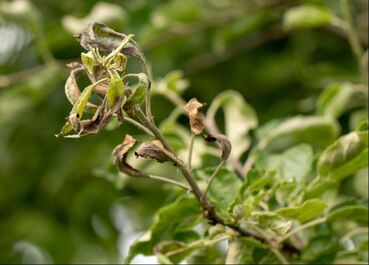 Fruit trees are both an attractive and beneficial addition to any landscape. Though, their health can be endangered by a bacterial disease called fire blight. How do I spot fire blight on a tree? Fire blight attacks fruit trees such as:
Tree damage can range from minor disfiguring to death. When are my trees at risk? The disease is active mostly in spring with its high humidity and prolonged rain. Late spring is also the time when microorganisms are from a dormant plant. Birds and insects are carriers of the disease, but humans also play a part. Practices like sprinkler irrigation, use of high nitrogen, fast release fertilizer and use of dirty pruning tools are all helpful in spreading fire blight. What should I look for? As is in the name, fire blight makes many parts of a plant look like it was burned. The disease affects every area of a tree the same way. Flowers Flower clusters or individual flowers look to be water soaked and ultimately drop, shrivel and turn black or brown. Fruit Similar to flowers, the fruit will turn black or brown and wilt. Twigs and Branches The end stages of the disease cause cankers to form and produces discolored oozing patches. The cankers have a water-soaked look before turning dry and sunken. Twigs turn a red-brown color and, often, develop into an inverted U-shape. Treatment and Management Fire blight bacteria will go on multiplying as long as ecological conditions are satisfactory. Therefore, it is critical to be active regarding management and treatment. A program of proper pruning, mulching, fertilization, and irrigation will help the tree’s natural ability to fight this disease. Pruning of all blighted branches and twigs can slow down the spread of the disease. This practice is most efficient when done during the dry, cold periods in late winter. After every cut, pruning tools have to be disinfected using a bleach and water solution. To manage a newly budding tree, don’t use high nitrogen, quick release fertilizers. To eliminate this disease from your trees, contact your local Tampa arborist. Comments are closed.
|
© Tree Service York PA 2016-2020
Leaders Heights | Jacobus | Emigsville | Mount Wolf | Manchester| Marietta | Bainbridge | Wrightsville | Dallastown |Windsor | East Prospect |York Haven | Red Lion | Dover | Loganville | Seven Valleys
Tree Service York PA
2536 Eastern Blvd #102
York, PA 17402
(717) 216-4888
2536 Eastern Blvd #102
York, PA 17402
(717) 216-4888
